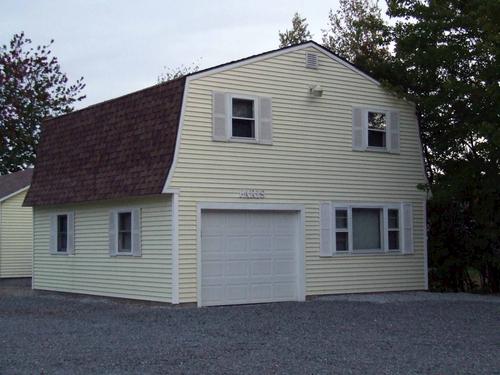
It is crucial to measure the width of your garage door. This will help you decide whether you need a standard or custom garage door. This will allow you to choose the right one for you. There are many types of doors available, including single, sectional and double.
Most residential garage door sections are split into smaller pieces. An 8-foot garage door with three sections will come with three 18 inch sections. If you need a wider opening, two 21-inch sections may be required. Sectional doors will also need 400mm of headroom. The rough opening will vary depending on the material used to make the header. No matter what header you choose, there should be enough space to support the garage door as well as its tracks.

Be sure to consider the width, as well. Most vehicles can fit into a standard-sized garage door. However, some trucks or recreational vehicles might require a larger size. If you want to build a custom garage door, make sure the door's overall width is not less than eight feet. To accommodate the door, you'll need to modify the framing.
Garage doors can be custom-made to fit any size garage. Most large manufacturers don't make custom sized doors, but if you know what you're looking for, you can have a door built to suit your specifications. These doors come in a wider width than standard doors so they might be more costly. They are usually wood doors.
As with any home, the garage size can depend on the architectural aspects of your house. Garage sizes are more varied in older homes than they are in newer ones. A standard two-car garage should typically measure around 18 feet by 22, feet. If you convert a garage to another purpose, add 12 inches. Also, if you're building a new home, you'll need to consider the size of the garage door.
Before you can begin building your garage, you need to know its exact dimensions. Once you know the exact size of your garage, you can calculate the door height and frame accordingly. Modern garage doors are typically nine feet by seven foot. However, that's not always the case. Some older homes may not have a standard size garage door opening.

The dimensions of your garage are important, regardless if you plan to build a home from scratch or just remodel an existing house. The best investment you can make is to get the garage door the right size. The width and height measurements of your existing garage door will help you determine the size. It is a good idea, once you've measured your door, to get an accurate measurement from a dealer.
FAQ
Is $30000 enough for a kitchen remodel?
You can expect to pay anywhere from $15000-$35000 for a kitchen overhaul, depending on how much money you have available. If you want a complete kitchen overhaul, expect to pay more than $20,000. For less than $3000, you can update appliances, add lighting, and replace countertops.
A full-scale renovation typically costs between $12,000 and $25,000 on average. There are ways to save money but not sacrifice quality. An example is to install a new sink rather than replacing an existing one that costs around $1000. You can also purchase used appliances at half of the cost of new.
Kitchen renovations take longer than other types of projects, so plan accordingly. You don't want to start working in your kitchen only to realize halfway through that you're going to run out of time before completing the job.
Start early. Start looking at options and collecting quotes from various contractors. Then narrow down your choices based on price, quality, and availability.
Once you've found a few potential contractors, ask for estimates and compare prices. It's not always the best option to go with the lowest price. It is important that you find someone with comparable work experience to provide an estimate.
Be sure to take into account all additional costs when you calculate the final cost. These extras could include labor and material costs, permits, or other fees. You should be realistic about what you can spend and stick to your spending budget.
You can be open about your dissatisfaction with any of these bids. If you don’t like the first bid, let the contractor know and offer to give it another chance. Don't let your pride prevent you from saving money.
What is included in a full-scale kitchen remodel?
A complete kitchen remodel is more than just installing a new sink or faucet. There are also cabinets, countertops, appliances, lighting fixtures, flooring, plumbing fixtures, and much more.
Homeowners can remodel their kitchens completely without needing to do major work. This means that no demolition is required, making the project easier for both the homeowner and the contractor.
There are many services that can be done to your kitchen, including plumbing, electrical, HVAC, painting, and carpentry. Depending on how extensive your kitchen renovation is, you may need multiple contractors.
It is best to work with professionals who have experience in kitchen remodeling. There are often many moving parts in a kitchen remodel, so small problems can cause delays. DIY kitchen remodels can be complicated. Make sure you have a plan and a backup plan in case of an emergency.
Why remodel my home when I can buy a brand new house?
It's true that houses get cheaper yearly, but you're still paying for the same square footage. Even though you may get a lot of bang for your buck, you also pay a lot for that extra square footage.
A house that isn't in constant maintenance costs less.
Remodeling your home instead of purchasing a new one can save you hundreds.
Remodeling your home can make it more comfortable and suit your needs. Your home can be made more inviting for you and the family.
What is the difference in a remodel and a renovaton?
Remodeling is the major alteration to a space or a part of a space. A renovation is a minor change to a room or a part of a room. For example, a bathroom remodeling project is considered a major one, while an upgrade to a sink faucet would be considered a minor job.
A remodel involves replacing an entire room or part of a whole room. A renovation is merely changing something in a particular room. For example, a kitchen remodel involves replacing counters, sinks, appliances, lighting, paint colors, and other accessories. You could also update your kitchen by painting the walls, or installing new light fixtures.
What would it cost for a home to be gutted versus what it would cost to build one?
The process of gutting a house involves removing all contents inside the building. This includes walls, floors and ceilings, plumbing, electrical wiring and appliances. It's often necessary when you're moving to a new house and want to make changes before you move in. Due to so many factors involved in the process of gutting a property, it can be very costly. Depending on your job, the average cost to gut a home can run from $10,000 to $20,000.
A builder builds a home by building a house frame-by-frame, then adds doors, windows, doors and cabinets to the walls. This usually happens after you have purchased lots of lands. Building a home is typically cheaper than renovating, and usually costs between $15,000-30,000.
It all comes down to what you want to do in the space. You'll likely need to spend more money if you want to gut a property. If you're building your home, however, you don't have to tear everything down and start over. You can design it yourself, rather than waiting for someone else.
How long does it typically take to renovate a bathroom?
It usually takes two weeks to remodel a bathroom. This can vary depending on how large the job is. A few small jobs, like installing a vanity or adding a bathroom stall, can be done in one day. Larger jobs like removing walls or installing tile floors and plumbing fixtures can take several hours.
The rule of thumb is that you should allow three days for each room. This means that if there are four bathrooms, you will need 12 days.
Statistics
External Links
How To
How to Install Porch Flooring
It is very simple to install porch flooring, but it will require planning and preparation. Before installing porch flooring, you should lay a concrete slab. A plywood deck board can be used in place of a concrete slab if you do have limited access. This allows you install the porch flooring easily without needing to make a large investment in a concrete slab.
The first step when installing porch flooring is to secure the subfloor (the plywood). You will need to measure the porch's width and cut two strips of plywood equal to it. These strips should be attached to the porch from both ends. Next, nail them down and attach them to your walls.
After securing the subfloor, you must prepare the area where you plan to put the porch flooring. This involves typically cutting the top layer from the floorboards to fit the area. Then, you must apply a finish to the porch flooring. Polyurethane is the most common finish. A stain can be applied to porch flooring. Staining is easier than applying a clear coat because you only need to sand the stained areas after applying the final coat of paint.
Once these tasks have been completed, you can finally put the porch flooring in place. Measure and mark the location for the porch flooring. Next, measure and mark the location of your porch flooring. Then, fix the porch flooring to its place using nails.
You can install porch stairs if you want to add more stability to your porch flooring. Porch stairs are often made from hardwood. Some people like to install their porch stairs before they install their porch flooring.
After you've installed the porch flooring, it's time for you to complete your project. You will first need to remove the porch flooring, and then replace it with a brand new one. Next, remove any debris. Be sure to remove all dirt and dust from your home.